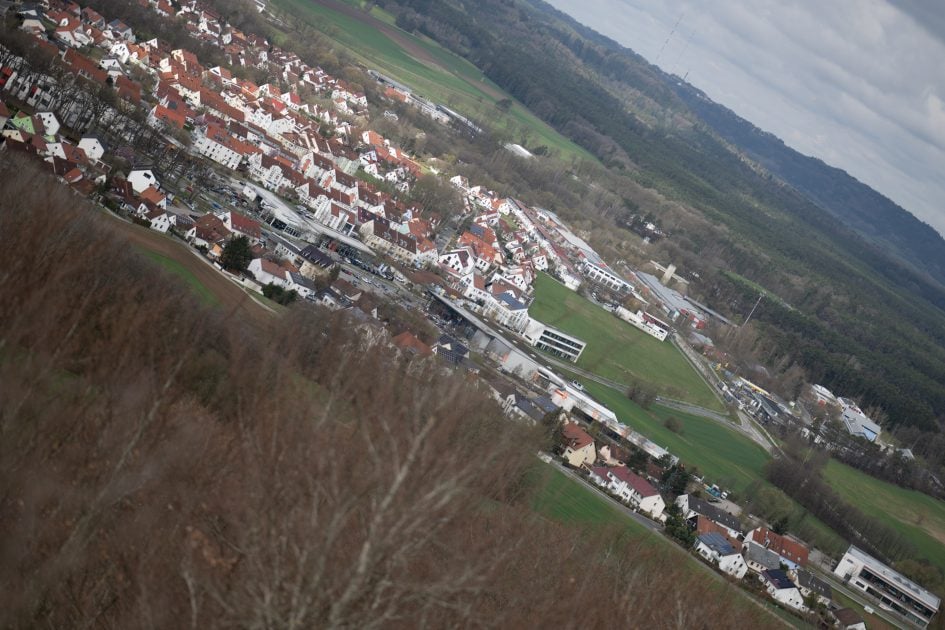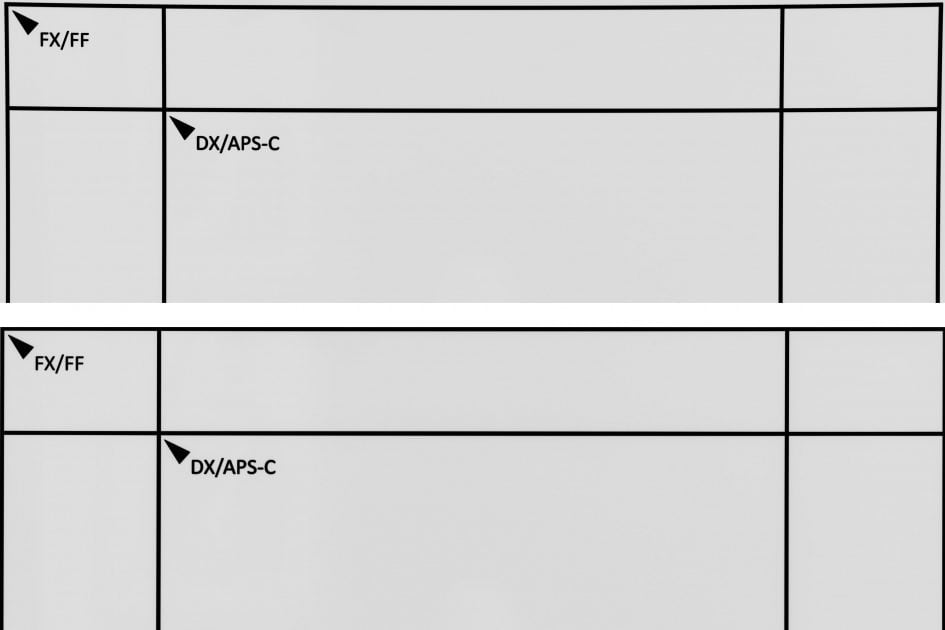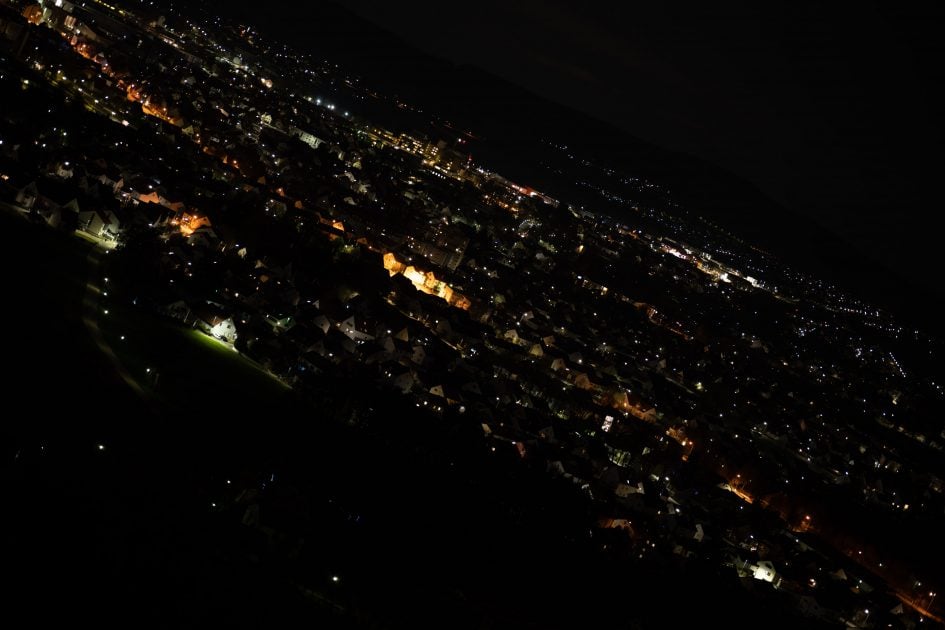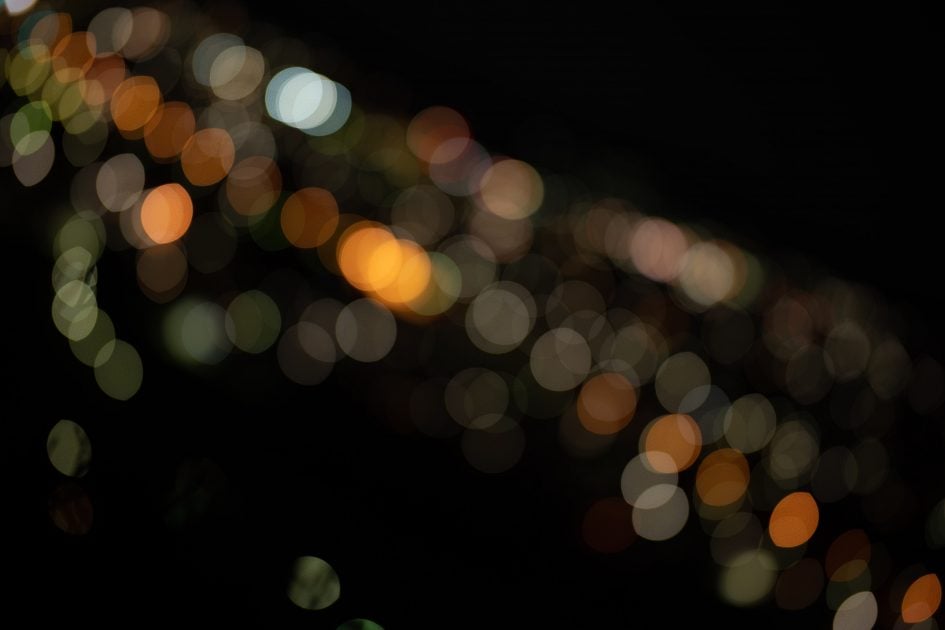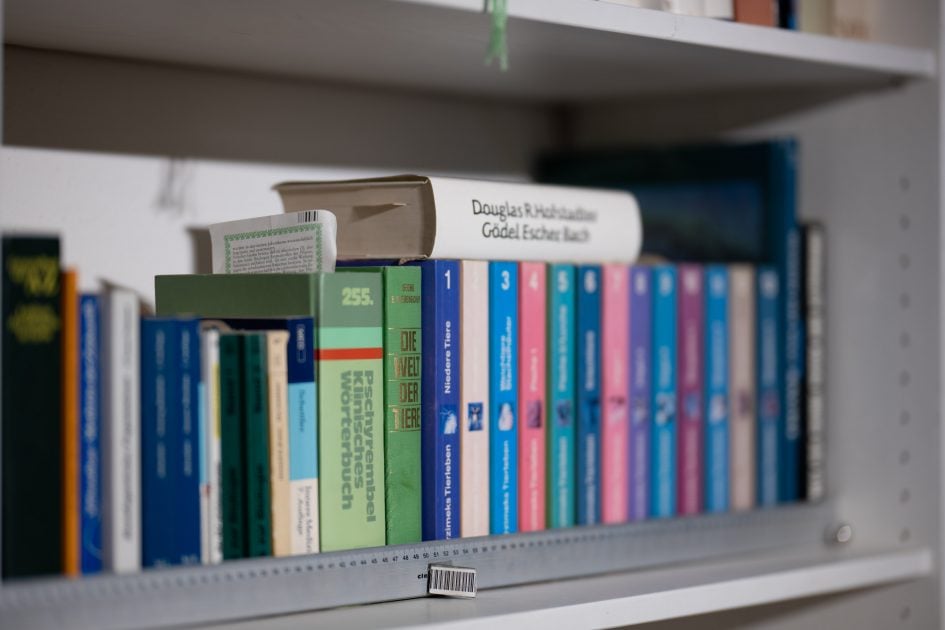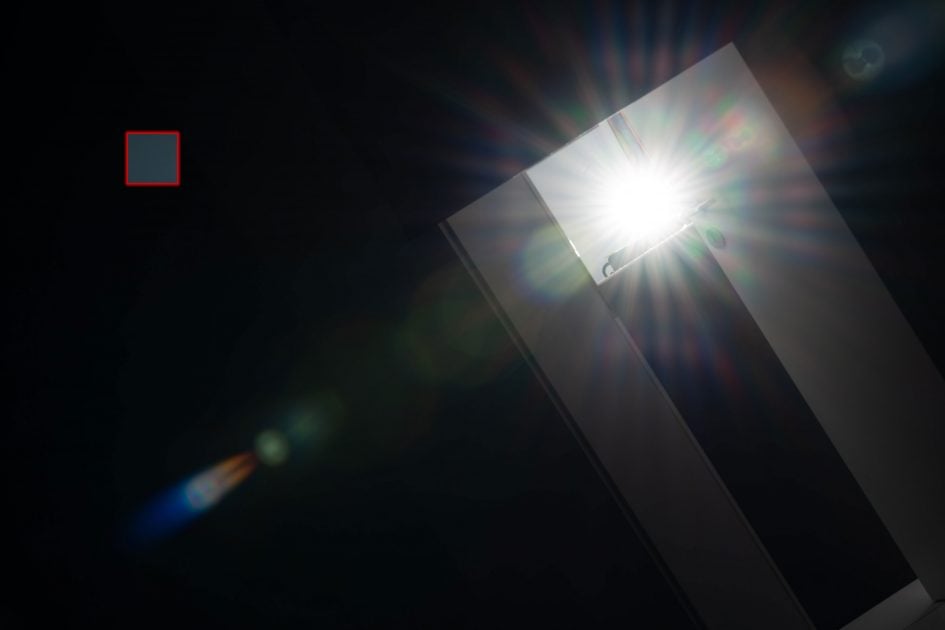Nikon Z 85mm f1.2 S review
-
-
Written by Thomas
Quality
Longitudinal Chromatic Aberration and focus shift
Lenses with focal ratios of f2.8 or larger are often prone to longitudinal color aberrations (loCA, a.k.a. “axial color” or “bokeh CA”). These show up as magenta coloration in the foreground and greenish hues in the background and are not easily corrected in post-processing. The Z 85mm f1.2 S shows very little loCA wide open:
Nikon Z 85mm f1.2 S Longitudinal Chromatic Aberration (loCA)
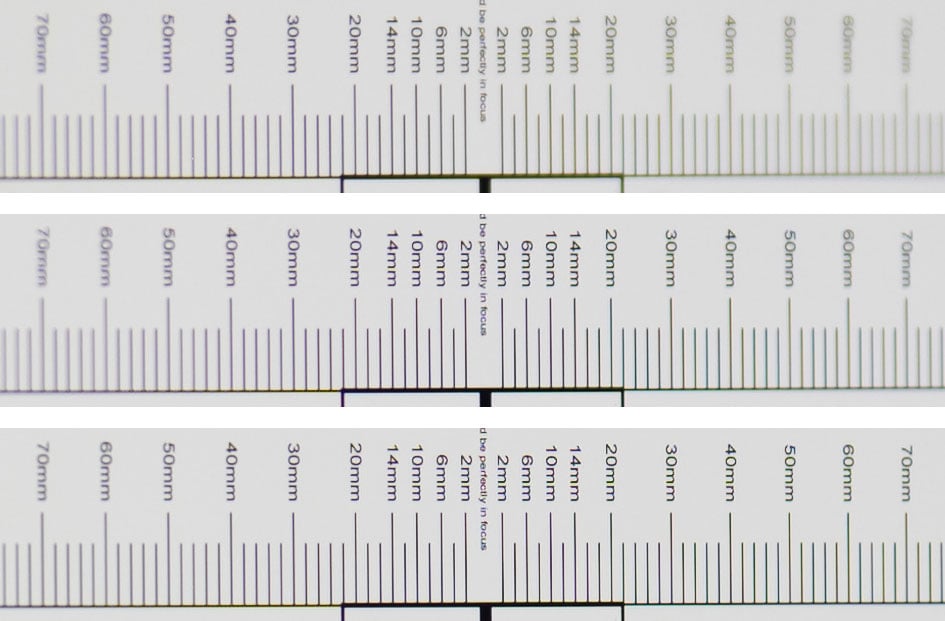
100% crops, from top to bottom: f1.2, f1.8, f2.8; left = foreground, right = background
The test also revealed that there is no focus shift to speak of although the background sharpens up faster than the foreground when the lens is stopped down. For comparison have a look at the Nikon Z 85mm f1.8 S (f1.8/f2.0/f2.8) and the Nikon Z 50mm f1.2 S (at f1.2/f1.4/f2.0).
The following real life shot shows that the Z 85mm f1.2 S produces practically no purple fringing around high-contrast edges in the focal plane but a slight bit of greenish outlining around background subjects. That’s comparable to the Nikon Z 85mm f1.8 S and clearly better than the Nikon Z 50mm f1.2 S.
Above: Nikon Z 85mm f1.2 S at f1.2; 100% crop; click image for 4k version, here for large original
Sharpness and contrast
Let’s have a look at the theoretical performance of the new Nikon Z 85mm f1.2 S and compare it to the performance of the Nikon Z 85mm f1.8 S, Zeiss Otus 85mm f1.4, and Nikon AF-S 85mm f1.4G:
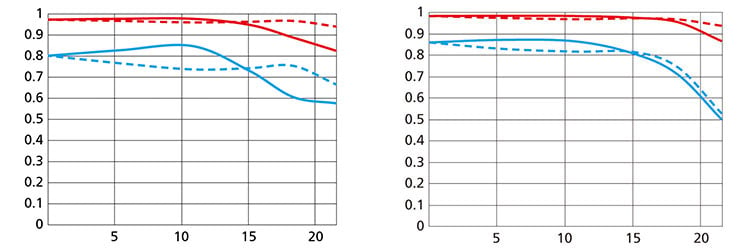
Above: Nikon Z 85mm f1.2 S at f1.2 (left), Z 85mm f1.8 S at f1.8 (right)
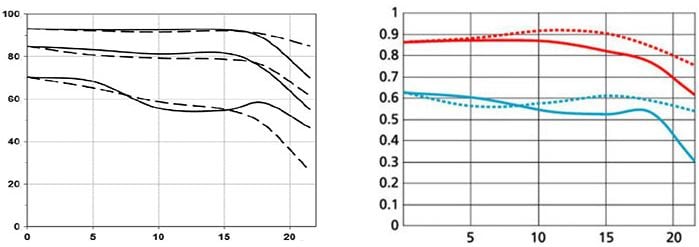
Above: Zeiss Otus 85mm f1.4 at f1.4 (left), Nikon AF-S 85mm f1.4G at f1.4 (right)
These MTF charts of the Nikon lenses show the computed lens-performance wide open without influence of diffraction at 10 line-pairs/mm (in red) and 30 lp/mm (in blue). The Zeiss Otus is shown at 10 lp/mm, 20 lp/mm, and 40 lp/mm. Higher values are better (more contrast) and the closer the dotted and solid lines are together the less astigmatism (= resolution depends on the orientation of the test-pattern) the lens has. The x-axis displays the “image height” which is the distance from the optical axis (=center of the sensor) in mm. I’ll show you the real-life performance at 4 mm (“center”), 13 mm (DX-corner), and 20 mm (FX-corner) on a 45MP Nikon Z7 camera.
From the charts the Nikon Z 85mm f1.2 S should be so much better than the F-Nikkor – even wide(r) open. No wonder: the Nikon AF-S 85mm f1.4G is now over 12 years old. Comparison to the Otus is hampered a bit by Zeiss including the softening influence of diffraction and using 20 and 40 lp/mm. From the MTF charts it could be a draw with the Zeiss Otus showing a soft decline of sharpness towards the corners while the Z 85mm f1.2 S shows an initial increase in sharpness up to 10mm image height – albeit with some astigmatism or field-curvature. Comparing both 85mm Z-Nikkors indicates that the Z 85mm f1.8 S should be sharper than its bigger sibling almost all the way into the FX-corner. But don’t forget that the Z 85mm f1.2 S is shown here at f1.2 which is over one stop more challenging than the f1.8 of the smaller lens.
So, let’s see how this theoretical performance of Nikon’s new Z-Nikkor translates into real life results in the sharpness test based on Siemens-stars and compare “apples to apples”. Processing was done in Lightroom 12.2/CRAW 15.2 from RAW to Adobe Color profile with the built-in lens profile compensating CA, distortions, and vignetting. Diffraction compensation was OFF. Noise-reduction is set to 0, sharpening to 50/0.5/36/10, with no extra tone, color, or saturation adjustment. White-balance was adjusted to a neutral white and I did some exposure compensation to make the brightness of all crops match. So you will not see light fall-off in the corners.
The following 100% crops show the Nikon Z 85mm f1.2 S from f1.2 down to f11 compared to the Mitakon 85mm f1.2, Zeiss Otus 85mm f1.4 (on FTZ adapter), Nikon Z 85mm f1.8 S, and Nikon AF-S 85mm f1.4G (shot on Nikon D800). I also included the Nikon Z 58mm f0.95 S Noct and Nikon Z 50mm f1.2 S for good measure to show the current state of affairs in very large aperture lenses from Nikon.
Nikon Z 85mm f1.2 S compared; 100% crop from center, DX-corner, FX-corner

Above: Nikon Z 85mm f1.2 S at f1.2

Above: Mitakon 85mm f1.2 at f1.2; also available at f1.4, f1.8, f2.0, f2.8, f4.0, f5.6, f8.0, f11

Above: Nikon Z 50mm f1.2 S at f1.2; also available at f1.4, f1.8, f2.0, f2.8, f4.0, f5.6, f8.0, f11

Above: Nikon Z 58mm f0.95 S Noct at f1.2; also available at f0.95, f1.4, f1.8, f2.0, f2.8, f4.0, f5.6, f8.0, f11
Looking at the center at f1.2 the Z 85mm f1.2 S is a bit softer than the Nikon Z 50mm f1.2 S and well behind the Z 58mm f0.95 S Noct. But the DX-corner clearly belongs to the Z 85mm f1.2 S: It is much sharper than the center and better than any other lens in this comparison. Keep in mind though that I had to re-focus as there is some field-curvature in play. The FX-corner of all three Nikkors looks comparable with a slight advantage for the Noct. And the Mitakon clearly is the softest lens in this comparison with a mushy DX-corner but still showing quite some detail in the center and FX-corner for such a cheap lens.
At f1.4 the Nikon AF-S 85mm f1.4G enters the competition but clearly is no match for the Z Nikkor although it benefits from being shot on the less demanding 36MP Nikon D800. I’ve also added the Zeiss Otus 85mm f1.4 which was my benchmark 85mm lens for DSLRs and still dominates the 85mm competition with its center performance. But the Z 85mm f1.2 S still “owns” the DX-corner.

Above: Nikon Z 85mm f1.2 S at f1.4

Above: Mitakon 85mm f1.2 at f1.4

Above: Zeiss Otus 85mm f1.4 at f1.4; also available at f1.8, f2.0, f2.8, f4.0, f5.6, f8.0, f11

Above: Nikon AF-S 85mm f1.4G shot on a 36MP Nikon D800 at f1.4
Stopping down to f1.8 finally gives the center of the Nikon Z 85mm f1.2 S a boost to very good acuity. But the Nikon Z 85mm f1.8 S now enters the comparison and proves to be almost as sharp across the full-frame sensor as the Z 85mm f1.2 S. The Mitakon 85mm f1.2 has also sharpened up nicely in the center but the DX-corner is still mushy.

Above: Nikon Z 85mm f1.2 S at f1.8

Above: Mitakon 85mm f1.2 at f1.8

Above: Nikon Z 85mm f1.8 S at f1.8; also available at f2.0, f2.8, f4.0, f5.6, f8.0, f11
Stopping the Z 85mm f1.2 S further down shows that from f2.8 onwards the lens also produces a very good FX corner:

Above: Nikon Z 85mm f1.2 S at f2.0

Above: Nikon Z 85mm f1.2 S at f2.8

Above: Nikon Z 85mm f1.2 S at f4.0

Above: Nikon Z 85mm f1.2 S at f5.6; also available at f8.0, f11
Performance at long distances
The Siemens-star test-targets are shot at a distance of 45x focal length (i.e. at around 4m for 85mm focal length). But performance of lenses also depends on the shooting distance. Therefore I present another series of test-shots of a city around 1 km away. Processing was done in Lightroom 12.2/CRAW 15.2 from RAW to Adobe Color profile with the built-in lens profile compensating CA, distortions, and vignetting. Diffraction compensation was OFF. Noise-reduction is set to 0, sharpening to 50/0.5/36/10, with no extra tone, color, or saturation adjustment. All shots were made from a heavy tripod at ISO 64 and image stabilization switched off.
The following images show the complete scene wide open plus 100% crops from the center, DX-corner, and FX-corner at various apertures. All crops in a row are from the same image so there is no compensation for field curvature. You can access the large originals but please respect our copyright and only use those images for personal use.
Above: Nikon Z 85mm f1.2 S at f1.2; click image for 4k version, large original available at f1.2, f1.8

Above: Nikon Z 85mm f1.2 S at f1.2

Above: Nikon Z 85mm f1.2 S at f1.4

Above: Nikon Z 85mm f1.2 S at f1.8

Above: Nikon Z 85mm f1.2 S at f2.0

Above: Nikon Z 85mm f1.2 S at f2.8

Above: Nikon Z 85mm f1.2 S at f4.0; also available at f5.6, f8.0
With focus set for the center field curvature makes the DX-corner of the lens a bit softer than in the test with Siemens-stars – softer in fact than the center. Looking closer at the center at f1.2 reveals some light spill around high-contrast edges which reduces micro contrast a bit. This improves already at f1.4 and again at f1.8 where the center becomes very sharp. Stopping the Z 85mm f1.2 S further down to f2.8 gives the DX- and FX-corner another boost in acuity until at f4.0 that lens looks perfectly sharp across the full-frame sensor – even when pixel-peeping. The test also reveals that there is astonishingly little light fall-off – even at f1.2. Have a look at the next section for more details.
Vignetting and distortions
To make it easier to see light fall-off in the corners of a full-frame sensor I’ve arranged a series of three shots each with the new Z-Nikkor from f1.2 to f2.0. All images were developed to the same brightness in the center and are shown with vignette control Off (1st row) resp. Normal (2nd row):
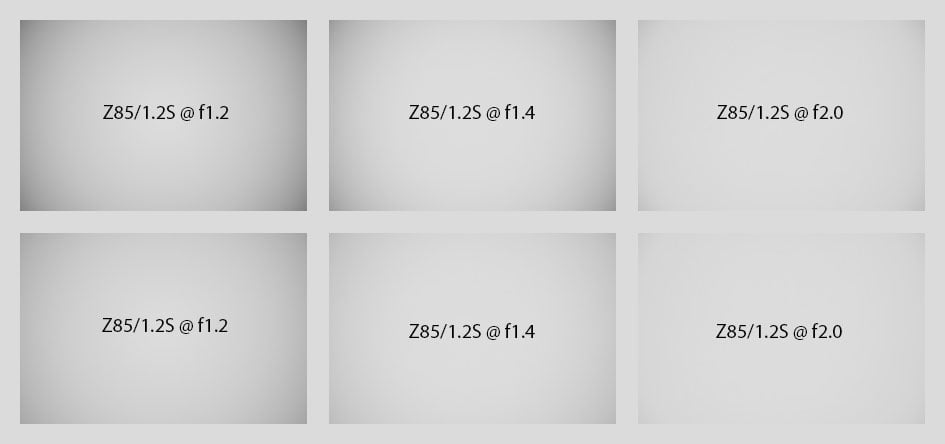
Above: Nikon Z 85mm f1.2 S at f1.2, f1.4, f2.0
The sample images above show that with the lens profile applied vignetting is pretty mild even at f1.2. From f2.0 onwards its imperceptible. At f1.2 vignette control set to Normal lifts the extreme corners by about 0.5-0.6 EV. Adobe’s RAW converter automatically applies vignette control as it was set in camera – but you cannot alter the setting in postprocessing.
That’s different with distortions: Adobe’s RAW converter ignores what was set in camera and always corrects them. So I had to do the following comparison with JPGs straight out of camera. The following composite image shows the upper half of a large screen TV set displaying grid lines for the full frame and cropped frame. Distortions are visibly pincushion which are perfectly corrected for by the lens profile:
Distortions: Nikon Z 85mm f1.2 S, as is (top) / with lens-profile (bottom)
Rendering of point-light sources at night-shots
Night-shots pose a different challenge for lenses as the contrast is even higher than under bright sun and point-light sources can reveal some weaknesses such as coma, haloing and colour-aberrations that do not show up as prominently in other test-shots. The 100% crops below the main image show the effect of coma in the FX-corner of the Nikon Z 85mm f1.2 S at various apertures:
Above: Nikon Z 85mm f1.2 S at f1.2; click image for 4k version, here for large original

Above from left to right: Nikon Z 85mm f1.2 S; 100% crops from the FX-corner at f1.2, f1.4, f2.0
The Nikon Z 85mm f1.2 S is not free of coma but it is certainly well controlled. By f2.0 it is practically gone.
Bokeh quality
This test is for the rendering of point-light sources in an out-of-focus background. The circle of confusion that is produced by this test is pretty indicative of Bokeh performance in the background. Ideally the out-of-focus image of the point-light is evenly lit and perfectly circular, with no “onion-rings”, and without coloration. Large aperture lenses normally produce an effect known as “cat’s eye” the further away from the optical axis the point-light is projected. This is due to optical vignetting in the lens barrel when light enters the lens from an angle.
The following crops at different apertures are from near the center, DX-corner, and FX-corner resized to make them comparable across all my reviews.
Above: Nikon Z 85mm f1.2 S at f1.2; click image for 4k version
Above: Nikon Z 85mm f1.2 S at f1.2; click image for 100% crop
Above: Nikon Z 85mm f1.2 S at f1.4; click image for 100% crop
Above: Nikon Z 85mm f1.2 S at f1.8; click image for 100% crop
Above: Nikon Z 85mm f1.2 S at f2.8; click image for 100% crop
The diameter of the Bokeh balls in the center is determined by the entrance pupil of the lens. So, at their respective largest aperture the Nikon Z 85mm f1.2 S produces 16% bigger Bokeh balls than the Z 58mm f0.95 S Noct and 50% bigger ones than the Z 85mm f1.8 S. Onion rings or texture within the Bokeh balls of the Nikon Z 85mm f1.2 S are practically a non-issue. Outlining is also very mild with almost no green coloration to it. Cat’s eyes towards the corners are pretty prominent but mostly gone at f2.0. But the edges of the aperture blades can clearly be seen from f2.8 onwards. Btw.: Nikon’s 135mm lens on their roadmap probably has a focal ratio of f1.8 which would let it produce even bigger Bokeh balls than the Z 85mm f1.2 S.
Let’s see how this analysis of out-of-focus point-light sources translates into Bokeh-performance shooting a book-shelf. Crops are from the foreground, middle-ground, and background resized to make them comparable across all my reviews. I added the Sigma Art 85mm f1.4 HSM to the mix as it reputably produced one of the best Bokehs for 85mm DSLR lenses. It was shot on a 35MP Nikon D810 but (like the test-shots of the Nikon AF-S 85mm f1.4G on a D800) the images are still comparable with regard to Bokeh as output sizes are identical. So, prepare for a very long list of crops (large originals also available):
Above: Nikon Z 85mm f1.2 S at f1.2
Above: Nikon Z 85mm f1.2 S at f1.2; click image for 4k version, also available as large original at f1.2, f1.8
Above: Mitakon 85mm f1.2 at f1.2; click image for 4k version, also available as large original at f1.2, f1.8

Above: Nikon Z 85mm f1.8 S at f1.8; click image for 4k version, here for large original

Above: Nikon AF-S 85mm f1.4G on a Nikon D800 at f1.4; click image for 4k version, here for large original

Above: Sigma Art 85mm f1.4 HSM on a Nikon D810 at f1.4; click image for 4k version, here for large original
Above: Nikon Z 50mm f1.2 S at f1.2; click image for 4k version, also available as large original at f1.2, f1.8

Above: Nikon Z 58mm f0.95 S Noct at f0.95; click image for 4k version, also available as large original at f0.95, f1.2, f1.4, f1.8
The Z 85mm f1.2 S clearly produces the softest transition zone behind the point of focus and background blur – even a bit smoother than the Z Noct. The Sigma Art 85mm f1.4 HSM scores third place in this comparison and while the Z 85mm f1.8 S is not bad it is clearly hampered by its smaller entrance pupil. Interestingly the Mitakon cannot score in the middle-ground as it produces a rather “squiggly” and nervous Bokeh.
Looking at the foreground crops shows the Noct in the lead followed by the Sigma Art, Z 85mm f1.2 S, Z 50mm f1.2, and Mitakon which are almost indistinguishable. Btw: Stopping the Z 85mm f1.2 S down to f1.8 produces a Bokeh which is comparable to the Z 85mm f1.8 S – in the center. But further away from the optical axis Bokeh of the Z 85mm f1.2 S still looks smoother than from its smaller sibling as the larger lens suffers less from clipping/vignetting/cat’s eye so its circles of confusion are more well rounded.
Looking at another crop (now at 100%) from the same image showing the ruler confirms again, that the Nikon Z 85mm f1.2 S has the smoothest transition zone with no tendency for double contours. Only the Noct shows a comparable quality.

Above: Nikon Z 85mm f1.2 S at f1.2; click image for 4k version, also available as large original at f1.2, f1.8

Above: Mitakon 85mm f1.2 at f1.2; click image for 4k version, also available as large original at f1.2, f1.8

Above: Nikon Z 85mm f1.8 S at f1.8; click image for 4k version, here for large original
Above: Nikon AF-S 85mm f1.4G on a Nikon D800 at f1.4; click image for 4k version, here for large original

Above: Sigma Art 85mm f1.4 HSM on a Nikon D810 at f1.4; click image for 4k version, here for large original

Above: Nikon Z 50mm f1.2 S at f1.2; click image for 4k version, also available as large original at f1.2, f1.8

Above: Nikon Z 58mm f0.95 S Noct at f0.95; click image for 4k version, also available as large original at f0.95, f1.2, f1.4, f1.8
Still the Z 85mm f1.2 S can produce double contours in the farther background like in this torture test with branches against a bright sky.
Now, if you’re curious how this all shapes up when shooting portraiture have a look at the next section.
Portrait performance
85mm focal length is the classical choice for portraits on a full-frame camera for upper body or full body shots. Let’s see how the new Z-Nikkor fares in this use-case. All shots were done with continuous AF with eye-detection and freshly focused for each shot. So there are some slight focus-differences which inevitably occur when you shoot a living, breathing subject.

Above: Nikon Z 85mm f1.2 S at f1.2; click image for 4k version, large original available at f1.2, f1.4, f1.8, f2.0, f2.8

Above: Nikon Z 85mm f1.2 S at f1.2, 50% crop; click image to view 100% crop
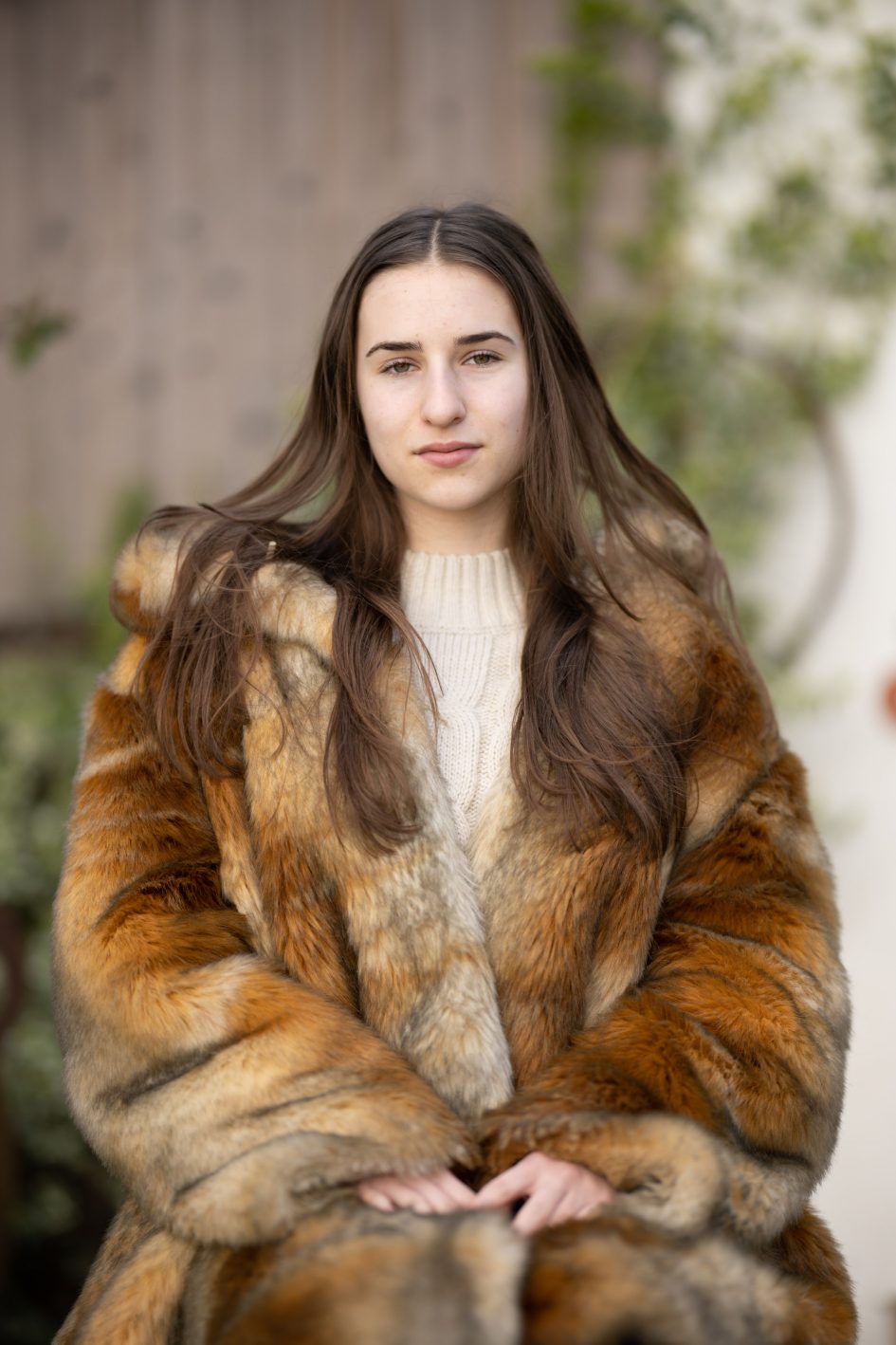
Above: Nikon Z 85mm f1.2 S at f1.2; click image for 4k version, large original available at f1.2, f1.4, f1.8, f2.0, f2.8

Above: Nikon Z 85mm f1.2 S at f1.2, 50% crop; click image to view 100% crop
Like in the tests before the lens reveals a slight reduction of contrast when used wide open but sharpens up immediately when stopped down to f1.4 of further. Many may prefer this characteristic in portrait shooting especially when it’s coupled with an exceptionally smooth Bokeh.
Flare, ghosting, and sunstars
Catching a strong light-source shining directly into the lens is always a risky business: it could produce strange colorful ghost-images or reduce contrast considerably through flare and glare. The appearance of flare and ghosting depends on factors like the aperture and the angle of the light hitting the lens. To judge the proclivity of Nikon’s Z 85mm f1.2 S for these artifacts I went through a series of well calculated shots against a strong light source to provoke glare and ghosting. The lens hood was mounted in all shots. Following is one of the more extreme example results. The little bright square inset in the upper left shows the respective area with an exposure compensation of +3 EV to make it easier to see which levels of black the lens renders at that point:
Above: Flare and ghosting. Strong light hitting the Nikon Z 85mm f1.2 S at f11; click image for 4k version or here for +3 EV exposure compensation
The lens produces clearly more flares and ghosts plus a stronger veiling glare than the Z 85mm f1.8 S or the Z 50mm f1.2 S when the light source is in the frame. But the effects are still pretty well controlled. Sunstars develop at f4.0 already and look very nice:

Above from left to right: Sunstars from the Nikon Z 85mm f1.2 S at f4.0, f5.6, f8.0, 100% crops
Next check out my sample images!
Check prices on the Nikon Z 85mm f1.2 S at B&H, Adorama, WEX UK or Calumet.de. Alternatively get yourself a copy of my In Camera book, an official Cameralabs T-shirt or mug, or treat me to a coffee! Thanks!
